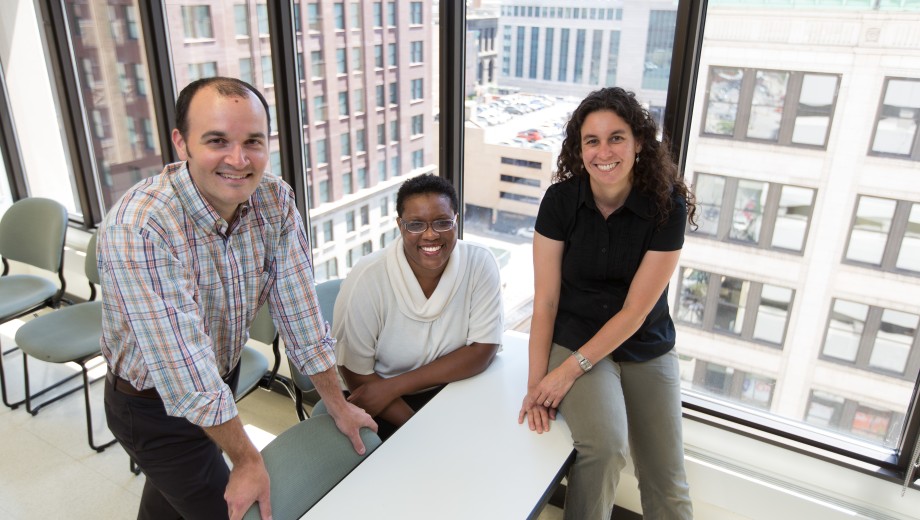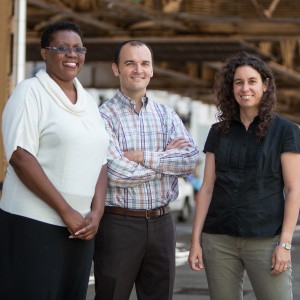After graduating from UChicago’s master of fine arts program in 2009, Amy Babinec sought positions in local community colleges for two reasons. The first—and practical—motivation was the existence of a number of community colleges in the Chicago area with active art programs. The second reason was more personal: “I went to community college,” Babinec says. “It’s where I started looking at art as a career.”
Babinec is now an adjunct instructor at suburban Moraine Valley Community College and Harper Community College. She’s one of many alumni who have found careers as adjunct instructors, tenured professors, and administrators at such institutions—which, according to the American Association of Community Colleges, serve nearly half of all undergraduates in the United States.
“What we’re always looking for is someone who loves teaching,” says Rosie Banks, AM’99, PhD’12, associate dean of instruction at Harold Washington College in downtown Chicago. Community college instructors are expected to teach multiple sections of their courses every semester, serve on faculty committees, and hold office hours for their students. The teaching load can be four or five courses per semester for tenured faculty like Jason Evans, AM’02, an English professor at Prairie State College in south suburban Chicago Heights.
Evans, a graduate of the Master of Arts Program in the Humanities (MAPH) who earned a PhD in English from the University of Illinois at Chicago, teaches composition and literature. He advises who take his UChicago course Teaching at Community Colleges “to draw on your education, not your expertise.” Professors at community colleges teach a wide variety of classes that may not be directly related to their graduate school specialization. “Be prepared to do more than your specific field,” suggests Andrew Fansler, MFA’10. A practicing sculptor, he has taught courses in art history, art appreciation, 3D art, and sculpture.
Most community colleges accept any student with a high school diploma or a GED. “We are open and accessible to anyone who walks through our doors,” says Banks. This policy produces an intellectually and demographically diverse student body. The average student at Prairie State is 29 years old, says Evans, and teaching an adult student population means his students have responsibilities—children, a full-time job, a mortgage—“that usually are not there for the traditional college student.”
The goals of each student differ as well: some are interested in an associate’s degree or transferring to a four-year university, while others are there for a certification or because they find the subject matter interesting. The community college’s job, Banks believes, is to “move them toward whatever their goals may be.”
Evans points out that adult learners are often his best students, because in many ways “it’s the perfect time to do college—you know what you’re doing and you have a sense of how special it is.” His writing and composition courses offer some of his most professionally rewarding moments. “I’m teaching people who may never have thought of themselves as thinkers or intellectuals,” says Evans. “I get to see them discover themselves as writers and as college students.”
As an art instructor at Forsyth Technical Community College in Winston-Salem, North Carolina, Fansler uses his students’ “diverse reads and diverse interpretations” to his advantage. “Art is a little more abstract” compared to other disciplines, he says, and allows for multiple interpretations. In a setting where some students are taking their first art course, their perspectives can spark open-ended conversations about the importance of art in everyday life.
Candidates for community college teaching jobs face similar challenges to those searching for jobs at four-year universities—tenure-track positions are difficult to find, and many instructors are hired on a part-time basis. Adjunct appointments may be as short as one semester and such instructors often receive low pay with minimal benefits.
Babinec, who was looking for a full-time position this past summer, says that the challenges of adjuncting extend into the classroom. She wants to build relationships with her students, but commuting between part-time jobs at two suburban schools and her Evanston home makes it difficult to be available for them.
For artists like Babinec and Fansler, adjunct positions do offer the benefit of flexibility. Babinec has more time to spend on her own practice and Fansler uses his summers off from teaching to do artist residencies. “Teaching is a good source of ideas for my own work,” he adds.
Balancing research and teaching can be difficult. Evans's time is spent primarily on teaching-related tasks for his composition and writing courses, not on his personal research. In response, he has merged his research interests with his teaching commitments to focus his scholarship on composition and the teaching of writing.
When hiring new instructors or observing her colleagues in the classroom, Banks looks for individuals who see teaching not as a skill to be mastered but as an intellectual practice. The task of reaching students, she says, is “intellectually what’s interesting for me.” She finds the greatest challenge and reward in helping her composition and literature students learn to ask questions and use critical-thinking skills.
The community college career route may not be for everyone, Evans admits. But after more than a decade, he continues to enjoy what he calls the “process of teaching”—of developing new ways to reach his students and help them grasp concepts that they can then use in future courses or in their daily lives. “It’s terribly exciting,” he says, “to be present for that moment.”



Comments
The community college connection with U of C
I am so pleased to read "Teaching Community" in this TABLEAU. It was not until after I earned my MA('70) and PhD('78) in English Language and Literature and began teaching at a community college that I learned that the first community college was founded by William Rainey Harper when he was president at the U of C. Joliet Junior College in Illinois was established 1903 as a pathway for students for the first two years of undergraduate education. Community colleges have become more comprehensive in their mission and now number 1200+ across the country. For the last twenty years I have been privileged to serve as President and Professor of English at Oakton Community College where I first served as Academic VP and Professor of English for ten years. I am profoundly grateful for the opportunities to be part of a number of community colleges, described by the late Ernest Boyer (Carnegie Foundation) as "democracy's colleges." And I am also grateful to my teachers, advisers, and mentors at U of C, especially Norman Maclean, Ned Rosenheim and Stuart Tave.